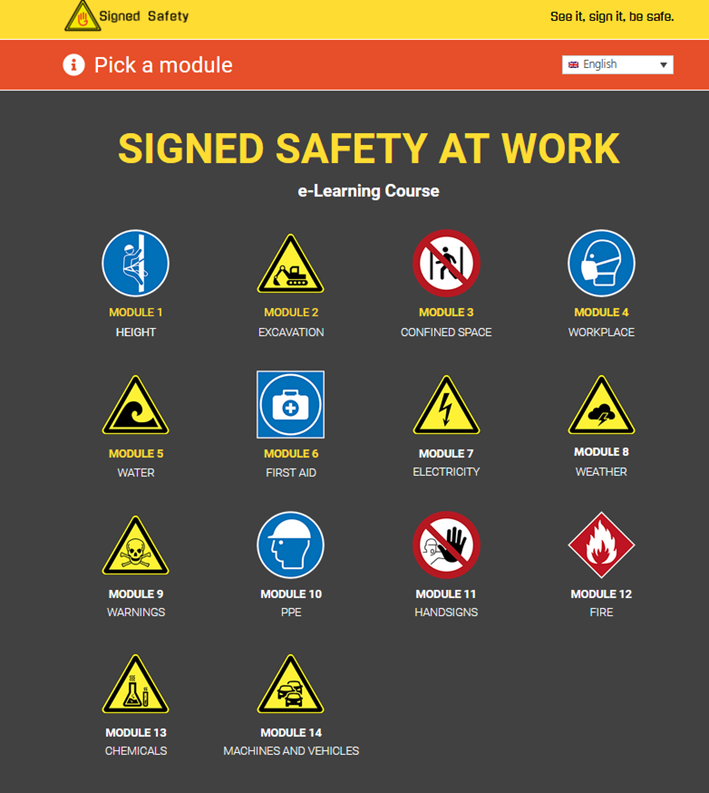The Signed Safety at Work project is now due to roll-out its e–Learning course defined by its 14 independent, self-standing sections. This will facilitate training for people to enhance the communication of Health & Safety measures in the workplace by using a bespoke glossary of hand signs designed for application in any workplace when communicating by speech and hearing may be impaired for some – or all – employees.
The course’s progress was marked by several stages in its development as it was constantly being improved through review and team collaboration as the Partners sought to ensure the course would meet the needs of current and future standards in Occupational Health and Safety.
Pacing progress
For the e–Learning software, the project Partners chose Articulate Storyline for its simplicity and flexibility. The adaptability was useful as some change was required regarding the introductory part, a part that gives learners that are wholly unfamiliar with sign insights concerning deafness and communications with Deaf people. This is quite separate from the 14 course sections, and the original presentation of the introductory part did not fit well with the design we had set for the course sections.
The first version of this part was designed partially like a cartoon, proceeding largely automatically to the next part at a pre-set time. However, it is very difficult to calculate the time to set for this, as slow readers may not be able to read all of the content in the time given, while faster readers may be bored because they cannot go on. This challenge can be met by using a “Continue” button, so the users may proceed at their own pace.
Making connections
A lengthy discussion took place among the Partners concerning how the courses should be connected. The original idea was to organise the course strictly as one large course with the 14 sections. However, without a Learning Management System (LMS), it was not possible for learners to save their work across all the sections they wanted to study and return to it at a later date. As implied by our choice of Articulate Storyline, we chose to work without an LMS in recognition of the need for simplicity and easy access to the platform.
While we see the course as having 14 sections, or modules, they are designed to stand independently of one another to the extent that different employees will need to study different sections to complete the course according to the needs of their position. For this reason, the evaluation of the learner’s competence takes place section by section. Having a certificate for each section completed satisfactorily shows their course competence through the collection of those certificates.
With this in mind, one of the Partners prepared an e-Learning website for each language (English, Italian, German) where the users can choose among the 14 sections and decide for themselves which sections, and how many of them, they want to do. Links to these webpages were added to the sections so that at the end of each section, when users can see an overview of all 14 sections, the users can decide if they want to repeat the section they have just done, or go back to any other section to repeat, or go on to a new one.
Certification
Articulate Storyline comes with an integrated certificate which can be modified by a programmer. The technicians from Universität Klagenfurt changed this certificate to a design suggested by the Austrian partner and approved by the other Partners.
When users finish a section, they can call up this certificate which includes the user’s name, the section title, the percent/points reached and the date and time of doing that section of the course. This certificate can serve as proof that a section – or ‘module’ in this context – has been successfully completed.
Post-review Feedback
Once the finishing touches were put on the 14 e-Learning sections in English language, the Partners tested the course after the first iteration and gave detailed feedback. Among several important details that were corrected, some new features were suggested as well.
For instance, further mouse-overs were added to icons in the exercises as the Partners felt that most of the icons on their own without text assistance were insufficient; that users might have trouble doing the exercise if the meaning of the icon is unclear. There was also discussion about shortening some texts even more for Deaf users.
Translations
The Italian and German Partners have now translated the contents into their languages; the work of integrating these translations into the original course sections is proceeding well and they should be available after the Easter holidays, in the second half of April 2021. At the same time, the contents will be checked and modified if necessary. The 14 sections and their translations had to be finished with due speed as they are needed presently for dissemination events that are taking place in the Partner countries during April, following one in the UK in late March.


